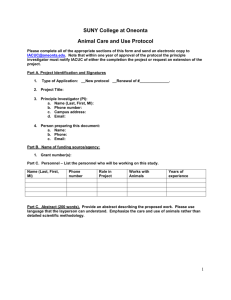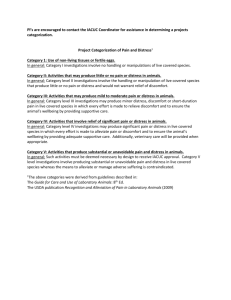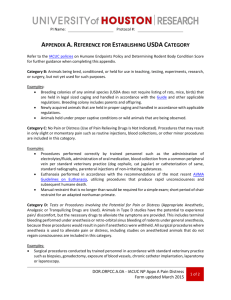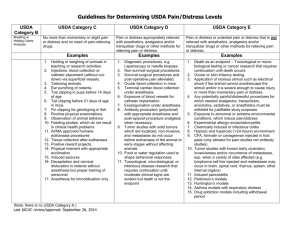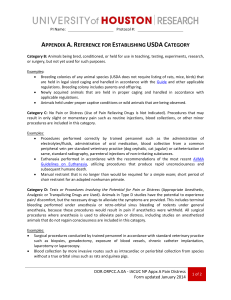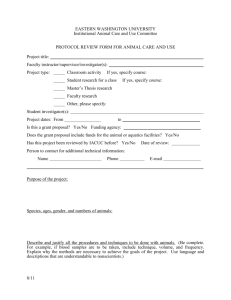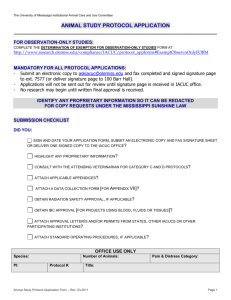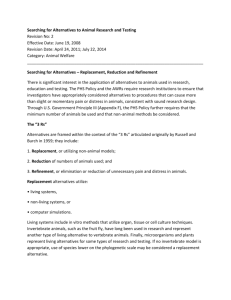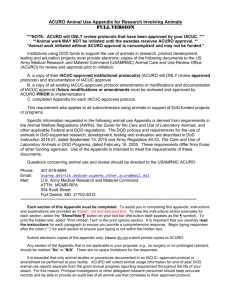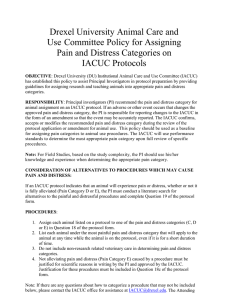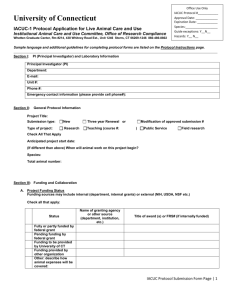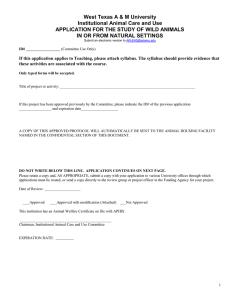Form
advertisement
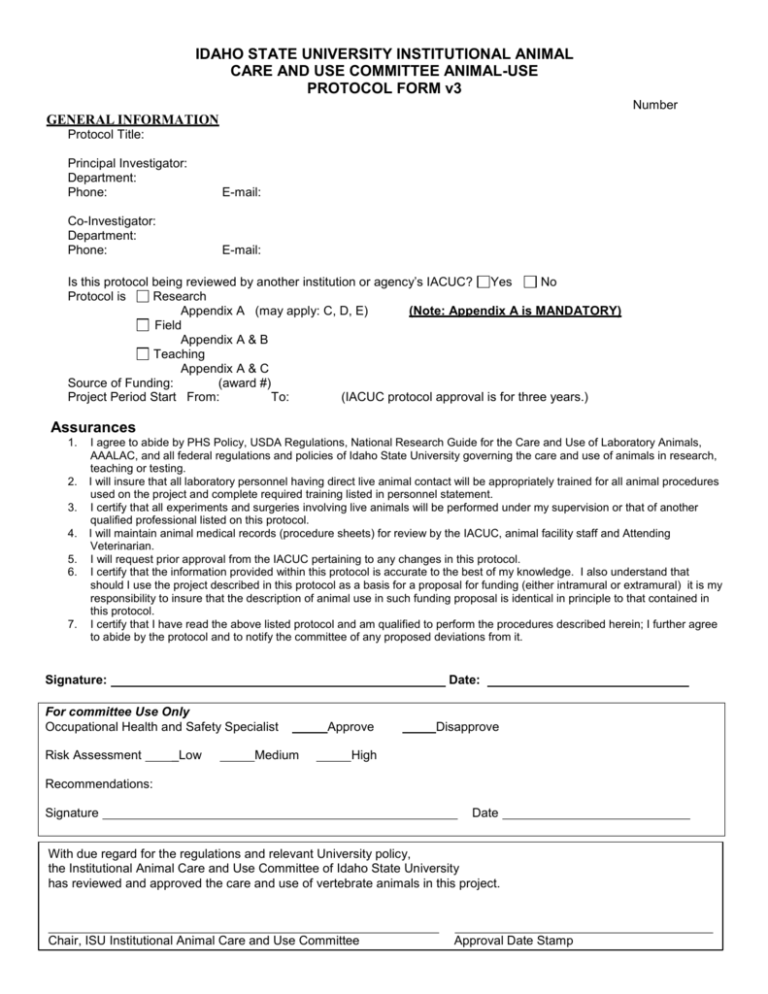
IDAHO STATE UNIVERSITY INSTITUTIONAL ANIMAL CARE AND USE COMMITTEE ANIMAL-USE PROTOCOL FORM v3 Number GENERAL INFORMATION Protocol Title: Principal Investigator: Department: Phone: E-mail: Co-Investigator: Department: Phone: E-mail: Is this protocol being reviewed by another institution or agency’s IACUC? Yes No Protocol is Research Appendix A (may apply: C, D, E) (Note: Appendix A is MANDATORY) Field Appendix A & B Teaching Appendix A & C Source of Funding: (award #) Project Period Start From: To: (IACUC protocol approval is for three years.) Assurances 1. 2. 3. 4. 5. 6. 7. I agree to abide by PHS Policy, USDA Regulations, National Research Guide for the Care and Use of Laboratory Animals, AAALAC, and all federal regulations and policies of Idaho State University governing the care and use of animals in research, teaching or testing. I will insure that all laboratory personnel having direct live animal contact will be appropriately trained for all animal procedures used on the project and complete required training listed in personnel statement. I certify that all experiments and surgeries involving live animals will be performed under my supervision or that of another qualified professional listed on this protocol. I will maintain animal medical records (procedure sheets) for review by the IACUC, animal facility staff and Attending Veterinarian. I will request prior approval from the IACUC pertaining to any changes in this protocol. I certify that the information provided within this protocol is accurate to the best of my knowledge. I also understand that should I use the project described in this protocol as a basis for a proposal for funding (either intramural or extramural) it is my responsibility to insure that the description of animal use in such funding proposal is identical in principle to that contained in this protocol. I certify that I have read the above listed protocol and am qualified to perform the procedures described herein; I further agree to abide by the protocol and to notify the committee of any proposed deviations from it. Signature: Date: For committee Use Only Occupational Health and Safety Specialist Risk Assessment _Low Medium Approve Disapprove High Recommendations: Signature Date With due regard for the regulations and relevant University policy, the Institutional Animal Care and Use Committee of Idaho State University has reviewed and approved the care and use of vertebrate animals in this project. Chair, ISU Institutional Animal Care and Use Committee Approval Date Stamp Please answer all questions or check N/A where applicable I. SIGNIFICANCE, RATIONALE AND ASSURANCE 1. Describe the specific goals of this project clearly and concisely. Use language understandable to nonscientists and avoid acronyms. a. What is the purpose of the study? b. What significance, rationale and potential benefits might be derived from the study? 2. Incorporate in your proposal the alternatives to animal use: reduction, refinement and replacement.(Simply stating, “no alternatives are available” is unacceptable). 3. Provide the following details for a literature search used to explore for alternatives to animal use and alternatives to painful procedures. Alternatives should be considered for any aspect of the protocol that may cause more than momentary or slight pain or distress. All protocols (research, field, and teaching) must conduct this search. a) Databases searched (at least two): Medline Library of Congress Animal Welfare Information Center National Agriculture Library ALTWEB Web of Science Other (please specify) b) List key words (minimum of five) used in the search: Date of search: Dates searched: Please give one or two sentences on the result of your search. II. ANIMAL USE Species Common Name Total Numbers ~Year 1 ~Year 2 Sex Age/Weight Source of Animals ~Year 3 1. Briefly describe the biological characteristics of the species that justifies its use in the protocol. Please do not list methods here. Cost should not be the primary justification. 2. Justify the number of animals to be used. 3. If you use DEA-controlled substances, please list their locations (building and room number). The IACUC is required to inspect these semi-annually. III. METHODS AND PROCEDURES 1. Type of procedure: See below Research Procedures: Type B: Experiments on vertebrate species that are expected to produce little or no discomfort. Type C: Experiments that involve some minor stress or pain (short-duration pain) to vertebrate species. Type D: Experiments that involve significant but unavoidable stress or pain to vertebrate species. Type E: Procedures that involve inflicting severe pain near, at, or above the pain tolerance threshold of conscious animals with no anesthesia. 2. Explain your selection. U.S. Government Principle IV: “Unless the contrary is established, investigators should consider that procedures that cause pain or distress in human beings may cause pain or distress in other animals.” Research Protocol-Main-Form-v3 (Word/docx) updated 8/21/15 Procedure: Provide a detailed procedure, in lay terms, understandable by a nonscientist, that effectively describes what happens to the animals from acquisition to euthanasia. If applicable, please describe surgical approach, suture, and procedures. Flow charts, diagrams or tables are strongly recommended for complicated experimental design. Where will procedures be performed? (Provide building and room number.) Sterile surgery suite Biology102 Non-sterile surgery area Pharmacy B20 Other ANESTHESIA (IF APPLICABLE) Drug Route of Delivery N/A Dose (eg., mg/kg) Schedule (e.g., times/day) Length of Anesthesia i. Who is responsible for maintaining anesthesia? (Animal must be under direct supervision until protective reflexes have returned) ii. Methods used to monitor anesthesia: iii. If inhalation anesthetics are used, describe the system for scavenging waste anesthetic gas. METHODS TO ALLEVIATE PAIN AND/OR DISTRESS. List analgesics, tranquilizers, ataraxic or behavioral modifications. If your procedure is likely to produce pain or distress, the use of analgesics, tranquilizers (or other methods to alleviate distress), is expected. OR you must provide a narrative to justify why no drugs or methods are used to alleviate pain or distress. None: (If none please justify): Drug/Class Dose (e.g., mg/kg) Route of Delivery RESTRAINT 1. Methods or devices used: 2. Duration of restraint is momentary or more than momentary. Explain/Describe methods used to alleviate stress due to more than momentary restraint. METHODS OF EUTHANASA/FINAL DISPOSITION All methods of euthanasia must follow the most current AVMA Guidelines on Euthanasia. 1. Methods are: a. Acceptable b. Acceptable with Conditions i. Justification (describe how conditions are met): Method Drug/Class Dose (e.g., mg/kg) Research Protocol-Main-Form-v3 (Word/docx) updated 8/21/15 Route of Delivery 2. Describe methods to ensure the animal will not revive: 3. Humane Endpoint(s). (Is the point at which pain or distress in an experimental animal is prevented, terminated, or relieved.) Provide plan to determine when an animal will be euthanized and removed from the study. Experimental Endpoint(s) (Occurs when the scientific aims and objectives have been reached.) Because of the potential for additional pain and distress justification is required. PAIN AND DISTRESS PRODUCING PROCEDURES - * This section to be filled out if the protocol is a type C, D, or E procedure. PROCEDURES Procedure to be applied to animals. 1. Describe pre-operative or preliminary procedures This includes procedures employed to ensure aseptic technique is maintained, ensure health of animals, surgical preps, drugs used, prophylactic measures, instruments. 2. Describe any potential post-operative or post procedure complications and methods to identify, assess, and manage these problems. 3. List all personnel who will handle the animals and state their prospective duties. (To be filled out by the principle investigator.) Where will surgical procedures be performed? (Provide building and room number.) 1. Sterile surgery suite 2. Non-sterile surgery area 3. Other 5. Describe long-term care of any chronic survival procedures: FIELD STUDY N/A APPENDIX B ATTACHED TEACHING N/A APPENDIX C ATTACHED ANIMAL HUSBANDRY N/A APPENDIX D ATTACHED BREEDING N/A APPENDIX E ATTACHED Research Protocol-Main-Form-v3 (Word/docx) updated 8/21/15
